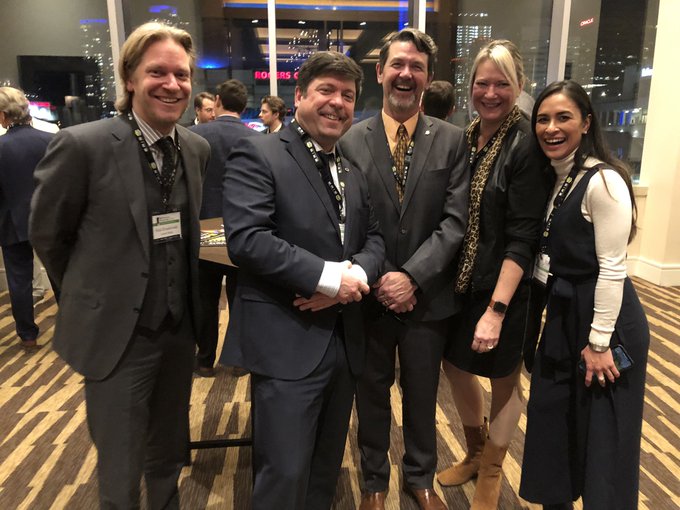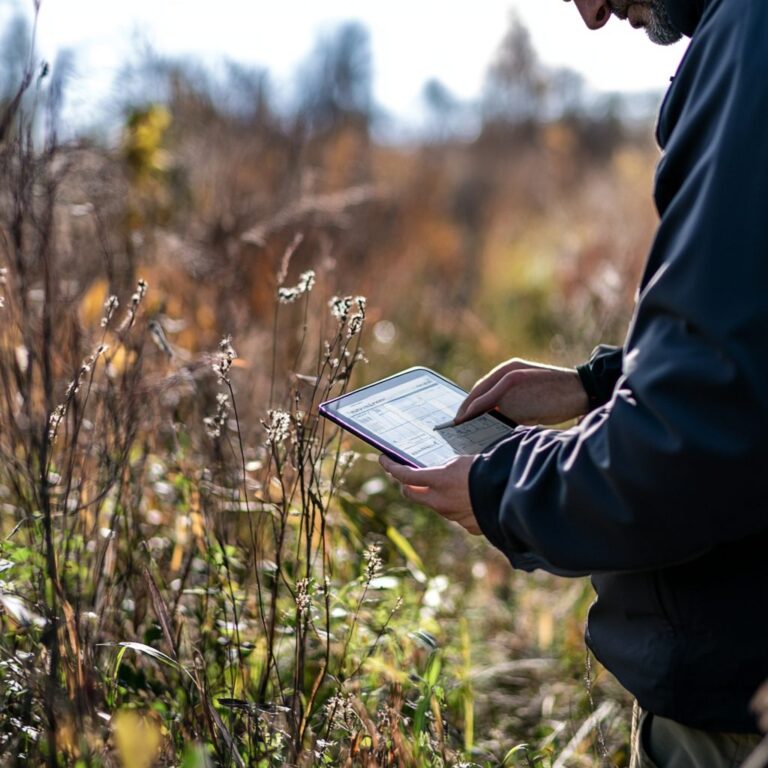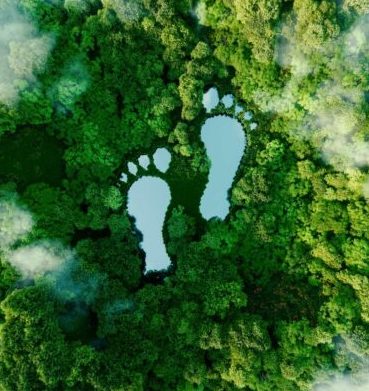Saturday, July 5, 2025
The best that Canada has to offer in the redevelopment of brownfield properties across the country were honoured as part of the 22nd Annual Brownie Awards, presented by Actual Media in collaboration with the Canadian Brownfields Network (CBN). The event was held last night at the Delta Hotel by Marriott in downtown Toronto.
Dedicated to the rehabilitation and revitalization of sites that were once contaminated, under-utilized, and undeveloped, the Brownie Awards provide annual recognition and celebration of brownfield projects, policies, and innovators across the country. These renewed residential and commercial projects contribute to the growth and resilient recovery of healthy cities and communities.
This year, the Brownie Awards committee, composed of a range of senior-level industry stakeholders, introduced the new award category of Refocus in order to highlight the efforts of brownfield projects or programs that demonstrate alignment with broader social initiatives and mandates.
“The redevelopment of brownfields provides important economic and environmental opportunities to create cleaner, safer, and more socially vibrant communities,” said Christopher De Sousa, chair of the Brownie Awards jury and past president of the board of directors of the CBN. “We’re proud to honour this year’s well-deserving award finalists, and to celebrate their outstanding achievements at this year’s Brownie Awards gala.”
Master of Ceremonies Todd Latham, president of Actual Media and a founder of the Brownie Awards, kicked off the event with a welcome back to the post-pandemic, in-person format, and reflected on the evolution of the industry.
“Tonight, we once again celebrate the best in the redevelopment and rehabilitation of ‘sites with personalities’ across Canada,” said Latham. “The industry has grown from that first year in 2000 with a handful of local speakers who were given recognition for just understanding what a brownfield was. Now we bring together hundreds of the industry’s champions for this annual celebration.”
Latham also acknowledged the important participation of the esteemed judging panel: Krista Barfoot of Stantec; Benoit Dion of Sanexen; Carla Guerrera of Purpose Driven Development & Planning; Meggen Janes of Geosyntec; Pam Kraft of the Toronto Transit Commission; Glenn Miller of the Canadian Urban Institute; Monisha Nandi of the Kilmer Brownfield Mgmt Ltd.; Pauline Pingusson of the Green Municipal Fund at the Federation of Canadian Municipalities; Eric Pringle of Milestone Environmental Contracting; Dianne Saxe of Saxe Facts and Deputy Leader of the Green Party of Ontario; and, Grant Walsom of XCG Consulting.

Master of Ceremonies Todd Latham with Krista Barfoot of Stantec, and a board member of the Canadian Brownfields Network (left) and Jackie Pagaduan, business development manager at Actual Media Inc.
Keynote speakers Michelle Ackerman, project director with Kilmer Infrastructure, and Matthew Hickey, lead architect with Two Row Architects, provided a project overview of a unique Indigenous development of Waterfront Toronto, delving into details on the project partnership approach, overcoming challenges through development and design, community benefits of the project, and an important focus on the integration of Indigenous design principles and partnerships.
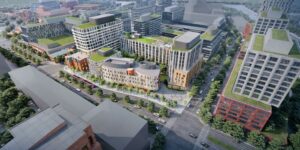
Once complete, Ontario’s first purpose-built Indigenous Hub will provide critical health care, and spiritual, employment, training, and family support for the local Indigenous community. The project team includes Dream Impact Trust, Kilmer Group, and Tricon Residential.

Michelle Ackerman explained the background of the the mixed-use project on Block 10 of Toronto’s West Don Lands, a legacy of the 2015 Pan Am/Parapan Am Games, which is built on lands transferred by the Province of Ontario to Anishnawbe Health Toronto.

Matt Hickey emphasized that ideas about Indigenous culture will be purposefully represented with Indigenous iconography and motifs in the building, honouring artistic and cultural representations, and meaningful landscape features will complement the existing natural environment.
The Brownie Awards 2021 champions honoured this year include the following:
REPROGRAM: Legislation, Policy and Program Initiatives
2020 Community Improvement Plan – St. Catharines, Ontario

The City of St. Catharines has one of the oldest community improvement plans in the Province of Ontario. The City of St. Catharines Community Improvement Plan (2020CIP) is a set of financial incentive programs offered by the municipality to the private sector, to help offset a portion of project costs related to redevelopment, reuse, and rehabilitation of the built environment and brownfield remediation.

The Reprogram award, sponsored by Willms & Shier Environmental Lawyers LLP, was accepted by Margaret Jospiovic for the City of St. Catharines.
REMEDIATE: Sustainable Remediation and Technological Innovation
Marwell Tar Pit Remediation – Whitehorse, Yukon
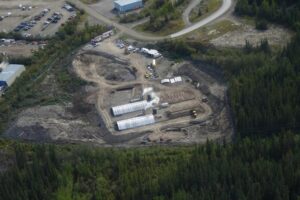 The Marwell Tar Pit, located in an industrial area adjacent to the downtown core of Whitehorse was the largest single‐source hydrocarbon contaminated site in the Yukon. In the 1940s, it was used as a disposal location for waste tar generated from a decommissioned World War II oil refinery and later as an unpermitted dump site for liquid wastes remaining exposed until the early 1960s when it was capped with gravel and cleaned up to commercial/industrial standards. Remediation involved an innovative cost-effective environmental soil treatment called enhanced thermal conduction.
The Marwell Tar Pit, located in an industrial area adjacent to the downtown core of Whitehorse was the largest single‐source hydrocarbon contaminated site in the Yukon. In the 1940s, it was used as a disposal location for waste tar generated from a decommissioned World War II oil refinery and later as an unpermitted dump site for liquid wastes remaining exposed until the early 1960s when it was capped with gravel and cleaned up to commercial/industrial standards. Remediation involved an innovative cost-effective environmental soil treatment called enhanced thermal conduction.

The Remediate award, sponsored by Milestone Environmental Contracting, was presented by Eric Pringle and accepted by Wayne Harris, on behalf of the project team.
REINVEST: Financing, Risk Management and Partnerships
Randle Reef Contaminated Sediment Remediation Project – Hamilton, Ontario
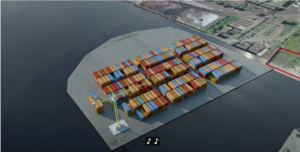
The Randle Reef Remediation project is an example of successful partnership and collaboration to move economic and ecological regeneration of a contaminated brownfield site forward through to cleanup. As the largest contaminated sediment remediation project in the Canadian Great Lakes, funding for it took shape through a shared vision to regenerate the harbour and agreement by multiple parties to contribute to the projected $139 million cost of the remediation.

The Reinvest award, sponsored by GFL Environmental, was presented by Ryan Moniz and accepted by Mark Seaman, on behalf of Environment Canada and PSPC.
REFOCUS: Alternative Benefits to Brownfield Remediation
150 Harrison Street Modular Housing Initiative – Toronto, Ontario
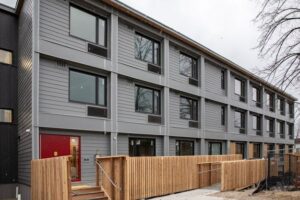
The project property is the location of a former police station. Given the presence of known contaminants, the project and design team assembled specifically included environmental consultants to ensure the modular housing development plan including identifying an approach that would fully address the contamination issues but also allow the project to be completed as quickly as possible. This brownfield development involved employing innovative modular construction techniques, resulting in the construction of a three-storey building containing multiple units offer support services to provide permanent, affordable housing to people experiencing or at risk of homelessness.

The new Refocus award, sponsored by Sanexen Environmental Services Inc., was presented by Ben Dion (right) and accepted by Peter Sutton of Terrapex (middle).
REBUILD: Redevelopment at the Local, Site Scale
Tower Automotive Building Adaptive Re-Use/Museum of Contemporary Art (MOCA) – Toronto, Ontario

The Auto Building was the subject of numerous development schemes prior to the decade during which it was vacant. A high level of public concern surrounded the site, and there was significant community interest in seeing a commercially viable solution that would also offer housing, employment, and amenity to the Lower Junction community. This project serves as a model for other architects and developers, whether working with vestigial industrial buildings or new-build structures, in the application and interpretation of municipal guidelines for preserving employment land and significant heritage assets.
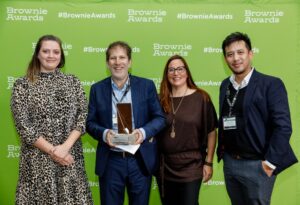
The Rebuild award, sponsored by Golder, a member of WSP in Canada, was presented by Denise Lacchin (third from left) and accepted by Adam Feldman of architects—Alliance (second from left).
RENEW: Development at the Community Scale
Historical North Vancouver Shipyards – North Vancouver, British Columbia

Activities from historical use as a shipyard produced metal and hydrocarbon contamination on a waterfront site in North Vancouver which required a multi-year environmental clean-up to bring the brownfield site up to numerical standards with removal of contaminated soil and risk assessments to protect human health and the environment to prepare the site for redevelopment. The area has transformed into a vibrant residential area around the site and residents are able to utilize the various restaurants, cafes, shops, and public spaces that offer outdoor seating and year-round programming.

The Renew award, sponsored by ECO Canada, was presented by Brenden Stephen and accepted by Tanisha Monster on behalf of the project team.
REACH OUT: Communications, Marketing and Public Engagement
Arbutus Greenway Design Vision and Implementation Strategy – Vancouver, British Columbia

The Arbutus Greenway Design Vision envisions the transformation of a 9km decommissioned rail corridor compromising 42 acres of open space into a destination which fosters movement and rich social interaction inspired by nature and the stories of the places it connects. By planning for a streetcar, the greenway makes way for future transit investment and transit supportive land uses in some of Vancouver’s lowest density neighbourhoods. When the design vision is realized, the greenway will make space for native planting, songbird and pollinator habitat, rainwater management, rolling and walking, and a series of public space destinations.
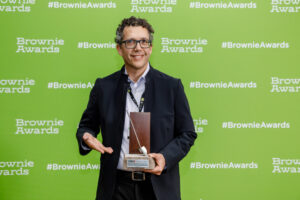
The Reach Out award, sponsored by the Federation of Canadian Municipalities, was accepted by Antonio Gomez-Palacio of Dialog and the project team.
BEST SMALL PROJECT
Richards Complete Streets – Vancouver, British Columbia

Richards Street is Vancouver’s first example of a blue-green system, an eight-block system that incorporates rainwater tree trenches and permeable pavement alongside an all ages and abilities separated bike lane. This blue-green system adds more than 100 new street trees that help manage and treat 15 million liters of rainwater runoff annually, diverting 11 million liters of urban rainwater from the sewers each year.
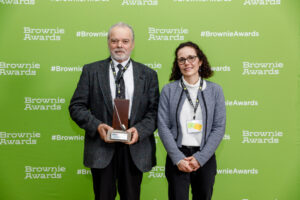
The Best Small Project award, sponsored by Terrapex, was presented by Jennifer O’Grady and accepted by Peter Simon of Deep Root, on behalf of the City of Vancouver.
BEST LARGE PROJECT
Environmental Remediation of the Turcot Site – Montreal, Quebec
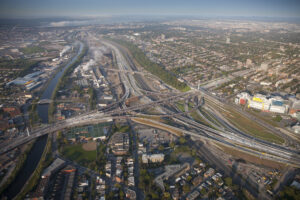
Stemming from a complex contamination heritage, an incredible volume of 3.2 million cubic meters of contaminated soils was remediated, from which a vast majority was kept safely on-site through a risk-assessment approach. While maintaining a daily traffic of an average of 300,000 vehicles, the construction crew rebuilt four interchanges and 145 km of roadways including bike paths creating additional space for public transit, pedestrian transportation, and green space.

The Best Large Project award, sponsored by The Cannington Group, was accepted by Nicolas Sbarrato of WSP in Canada (centre).
BEST OVERALL PROJECT
Don Mouth Naturalization and Port Lands Flood Protection Project: Treatment Technology Evaluation Program – Toronto, Ontario

The treatment technology evaluation program for this brownfield project was part of a larger initiative to unlock 356 hectares of contaminated land for transformation into a vibrant mixed-use community in close proximity to Toronto’s core. The program involved the selection, assessment, and documentation of 11 innovative technologies which have the potential to be part of the ultimate remedial action plan for the Port Lands project as well as other brownfield redevelopment sites across Canada.
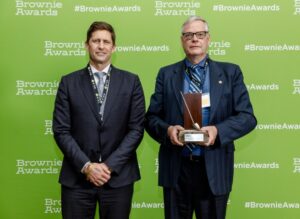
The Best Overall Project award, sponsored by The Kilmer Brownfield Equity Group, was presented by David Harper and accepted by Don Ford of Toronto Region Conservation Authority.
BROWNFIELDER OF THE YEAR: Monisha Nandi

Monisha Nandi won the prestigious Brownfielder of the Year Award and dons the traditional BOTY hat.
Monisha Nandi is the environmental director at Kilmer Brownfield Management and a champion for brownfield redevelopment, both as a volunteer and practitioner. Nandi is a long-time member of the board of the Canadian Brownfields Network (CBN) and served for many years as the chair of CBN’s technical advisory committee and the Brownie Awards judging committee. She is also an active participant of the Ontario Environmental Industry Association (ONEIA) Brownfield Committee, supporting outreach, advocacy, and cross-collaboration activities between ONEIA and CBN.
With her range of professional experience in the public and private sectors, Nandi has represented industry, legal, consulting, and development elements of the brownfield revitalization process. She is uniquely qualified to approach brownfield redevelopment holistically, recognizing all the various factors that can impact a brownfield project and dictate its likelihood of success. Fortunately for the brownfield community, she frequently shares this knowledge through public speaking opportunities, demonstrating an exceptional ability to communicate technical, legal, project management, and other business issues to a diverse audience. Through her outreach work and engagement with CBN and ONEIA, Nandi actively promotes the use of brownfields as part of strategic urban revitalization planning.
This year’s Brownie Awards brought together more than 180 participants from across the country to enjoy an evening of recognition, celebration, and industry networking.
Great to gather in person at the Brownie Awards, from left to right: Nick Krukowski of Actual Media; Martin Bureau of Sanexen; Todd Latham of Actual Media; Linda Latham of Professional Engineers of Ontario; and, Jackie Pagaduan of Actual Media.
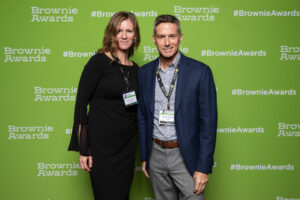
Corinne Lynds of Actual Media Inc. with Brian Eastcott of ERIS.

The ECO Canada team: Frank Rukundo, Brenden Stephen, and Simon Savinel.
![]()
For further information on the Brownie Awards and more event photos, please click here.




